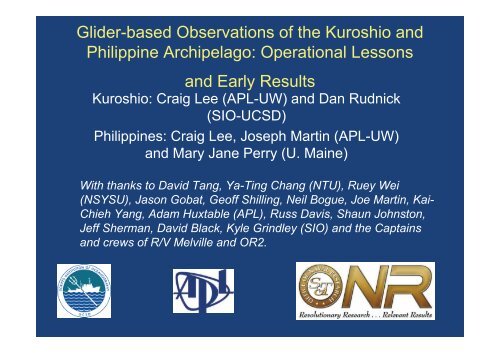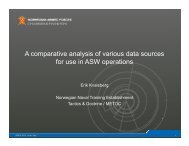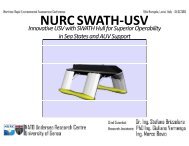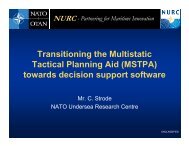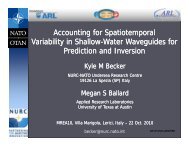Glider-based Observations of the Kuroshio and Philippine Archipelago
Glider-based Observations of the Kuroshio and Philippine Archipelago
Glider-based Observations of the Kuroshio and Philippine Archipelago
- No tags were found...
Create successful ePaper yourself
Turn your PDF publications into a flip-book with our unique Google optimized e-Paper software.
<strong>Glider</strong>-<strong>based</strong> <strong>Observations</strong> <strong>of</strong> <strong>the</strong> <strong>Kuroshio</strong> <strong>and</strong><strong>Philippine</strong> <strong>Archipelago</strong>: Operational Lessons<strong>and</strong> Early Results<strong>Kuroshio</strong>: Craig Lee (APL-UW) <strong>and</strong> Dan Rudnick(SIO-UCSD)<strong>Philippine</strong>s: Craig Lee, Joseph Martin (APL-UW)<strong>and</strong> Mary Jane Perry (U. Maine)With thanks to David Tang, Ya-Ting Chang (NTU), Ruey Wei(NSYSU), Jason Gobat, Ge<strong>of</strong>f Shilling, Neil Bogue, Joe Martin, Kai-Chieh Yang, Adam Huxtable (APL), Russ Davis, Shaun Johnston,Jeff Sherman, David Black, Kyle Grindley (SIO) <strong>and</strong> <strong>the</strong> Captains<strong>and</strong> crews <strong>of</strong> R/V Melville <strong>and</strong> OR2.
Objectives• Technical– Demonstrate utility <strong>of</strong> gliders for sampling strongboundary currents <strong>and</strong> complex archipelagoenvironments.• Scientific– Characterize <strong>the</strong> annual cycle <strong>of</strong> <strong>the</strong> <strong>Kuroshio</strong> <strong>and</strong>associated mesoscale field.– Quantify spatial structure, temporal evolution.– Underst<strong>and</strong> <strong>the</strong> means <strong>and</strong> direction by whichsignals propagate through a complex archipelago(e.g. multiply connected straits or interconnectedbasins).
Spray <strong>and</strong> Seaglider• ~50 kg•~2 m length• Deploy/recover onsmall boats →research vessels
<strong>Glider</strong> operations • Cycle 0-1000 m, ~6 km, ~6 hours• Horizontal velocity ~0.25 m/s (20km/day)• Vertical velocity ~0.1 m/s• Typical deployment 3-5 months,longest to-date 7 months.• Endurance depends on ambientstratification, dive depth <strong>and</strong>desired speed.Extended endurance…- Remote deployment (swim in)- Persistent presence (patrol).Slow speeds limit synopticity,rapid response.Can compensate by using moregliders.• 2-way Iridium comms, slowremote control• Temperature, salinity, pressure,current, optics, dissolved oxygen,depth-average velocity (inferred).• New developments: One-yearendurance, under-ice (acousticnav), hardening, new CPU.http://iop.apl.washington.edu
Progress<strong>Kuroshio</strong>• Two gliders deployed (1 APL, 1 SIO,) April,recovered July 2007.‣ 400 dives up to 1000 dbar‣ 2000 km distance‣ 100 days• Four gliders deployed (2 APL, 2 SIO) July, replacewith four fresh gliders in October 2007.<strong>Philippine</strong>s• Pilot deployments- 2 APL seagliders (sou<strong>the</strong>rnMindoro Strait <strong>and</strong> Mindinao Sea).‣ Little historical data- exploratory measurements<strong>and</strong> operational evaluation.‣ Assess potential risks due strong currents,complex geometry <strong>and</strong> heavy fishing.
Model Currents•Usefulplanning <strong>and</strong>piloting tool• Modeledfeatures <strong>of</strong>tenqualitativelysimilar to thoseobserved bygliders
<strong>Glider</strong> tracks
• Controlled navigation where currents weaker thanglider speed.• Must work with current when flow is strong.• At extremes glider behaves like a float.• Mesoscale variability dominates flow field.• <strong>Kuroshio</strong> present, but <strong>of</strong>ten obscured by mesocale.• Strong currents extend to coast.• <strong>Kuroshio</strong> weak <strong>of</strong>f Luzon, streng<strong>the</strong>ns northward?
Optimum <strong>Glider</strong> PathsNorthward current,exponential pr<strong>of</strong>ileNormalized by glider speedMin distance, time pathsInitial position (1.5,0)Waypoint (0,0)<strong>Glider</strong> heading, degrees true<strong>Glider</strong> speed over ground,normalized by speedthrough water
Multiple Occupations <strong>of</strong> a SectionSPSGSGSGSPSP
<strong>Philippine</strong>s: Exploratory MissionsMindinao Sea• Strong currents,internal tide ateastern end.• Weak flow atwestern boundary.• Self-inflicted errorpinned glider onsurface, fishing boat‘recovery’ < 48 h.Sou<strong>the</strong>rn Mindoro Strait• Compass failure (bogus strongcurrents, poor navigation) endedmission prematurely.• Hint <strong>of</strong> anticyclonic circulation.
0.25 kg/m 3 contoursSprayDeployment1Section 3
SeagliderDeployment1Section 4PotentialTemperature,Salinity, <strong>and</strong>Potential Density
Velocity Autocovariance
Observed Currents during SW <strong>and</strong> NE Monsoons30 m shipboard ADCP(Liang et al. 2003)


